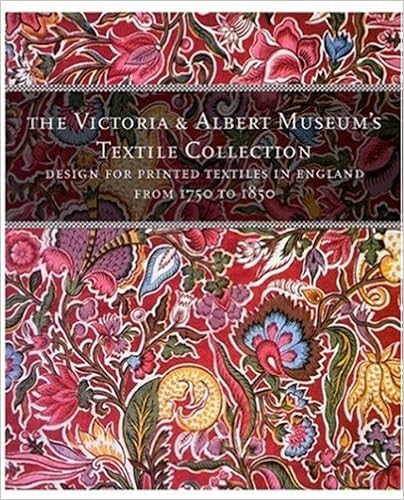Tuesday, June 20, 2017
Book Review: Designs for Printed Textiles in England from 1750 to 1850
Designs for Printed Textiles in England From 1750 to 1850 by Wendy Hefford
Though not a recent book (1992), this one was new to me. And I was missing out by not knowing about it sooner!
I've reviewed fabric design books before (see here, here, here, and here), and where Designs for Printed Textiles stands out is in the size and quality of its images. Written information is brief, concise, and in 10pt font (or smaller). The 236 samples are spread over 118 pages, allowing each image considerable space--most have an entire 10" x 12" page, or at least half of one; the handful of pages with four or more samples are all copies of period albums and sample books. Some unusual specimens were included such as printed shawls and patchwork quilts containing many printed fabrics.
Compared to other works, this book has relatively few examples and a narrow scope: as the name indicates, it's all British printed fabrics from 1750-1850 (which are now in the The Victoria & Albert Museum). Within that, various types of printed fabric are featured: furnishing fabrics, dress goods, shawls, etc. The book seemed to contain more pages covering the late 18th century than early 19th (maybe 60% to 40%), so it may be more useful for people interested in the early part of the year range than the later. While the bulk of the book is colored plates, there were also 7 pages of background information on styles/processes/technology, 17 pages of captions for the plates, 2.5 pages for a fabric glossary, and 3 pages about the history of different British fabric printing companies.
With all that in mind, I'd say this book is very useful for looking at changes occurring in British fabric printing over a hundred-year period, and fairly to very useful for looking at designs within that time period. In most cases, you won't be finding multiple examples of a specific type of material for a narrower year range--but the one or two pictures that you do find will be lovely and detailed. I won't be making this my primary textile print resource, but I think it's a very useful addition to the library, and a good choice to consult before embarking on a late 18th (or early 19th) century project.
Score: 5 stars
Accuracy: High. All original examples
Strongest Impression: A pretty book which gives good, detailed examples of textile prints over a century.
Subscribe to:
Post Comments (Atom)

No comments:
Post a Comment
Thanks for commenting!